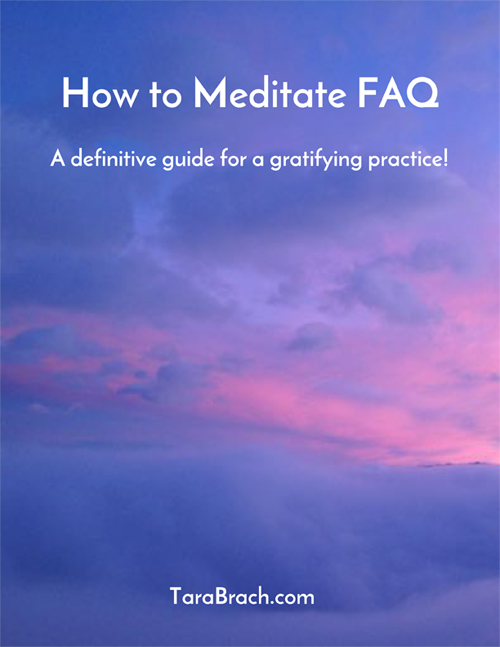NOTE: See updated explanation and more RAIN resources here.
Adapted from Tara’s book: True Refuge: Finding Peace & Freedom in Your Own Awakened Heart (Bantam, 2013)
Also available in .pdf (22KB)
About twelve years ago, a number of Buddhist teachers began to share a new mindfulness tool that offers in-the-trenches support for working with intense and difficult emotions. Called RAIN (an acronym for the four steps of the process), it can be accessed in almost any place or situation. It directs our attention in a clear, systematic way that cuts through confusion and stress. The steps give us somewhere to turn in a painful moment, and as we call on them more regularly, they strengthen our capacity to come home to our deepest truth. Like the clear sky and clean air after a cooling rain, this mindfulness practice brings a new openness and calm to our daily lives.
I have now taught RAIN to thousands of students, clients, and mental health professionals, adapting and expanding it into the version you’ll find in this chapter. I’ve also made it a core practice in my own life. Here are the four steps of RAIN presented in the way I’ve found most helpful:
- R – Recognize what is happening
- A – Allow life to be just as it is
- I – Investigate inner experience with kindness
- N – Non-Identification.
RAIN directly de-conditions the habitual ways in which you resist your moment-to-moment experience. It doesn’t matter whether you resist “what is” by lashing out in anger, by having a cigarette, or by getting immersed in obsessive thinking. Your attempt to control the life within and around you actually cuts you off from your own heart and from this living world. RAIN begins to undo these unconscious patterns as soon as we take the first step.
Recognize what is happening:
Recognition is seeing what is true in your inner life. It starts the minute you focus your attention on whatever thoughts, emotions, feelings or sensations are arising right here and now. As your attention settles and opens, you will discover that some parts of your experience are easier to connect with than others. For example, you might recognize anxiety right away, but if you focus on your worried thoughts, you might not notice the actual sensations of squeezing, pressure or tightness arising in the body. On the other hand, if your body is gripped by jittery nervousness, you might not recognize that this physical response is being triggered by your underlying belief that you are about to fail. You can awaken recognition simply by asking yourself: “What is happening inside me right now?” Call on your natural curiosity as you focus inward. Try to let go of any preconceived ideas and instead listen in a kind, receptive way to your body and heart.
Allow life to be just as it is:
Allowing means “letting be” the thoughts, emotions, feelings or sensations you discover. You may feel a natural sense of aversion, of wishing that unpleasant feelings would go away, but as you become more willing to be present with “what is,” a different quality of attention will emerge. Allowing is intrinsic to healing, and realizing this can give rise to a conscious intention to “let be.”
Many students I work with support their resolve to “let be” by mentally whispering an encouraging word or phrase. For instance, you might feel the grip of fear and whisper “yes” or experience the swelling of deep grief and whisper “yes.” You might use the words “this too” or “I consent.” At first you might feel you’re just “putting up” with unpleasant emotions or sensations. Or you might say “yes” to shame and hope that it will magically disappear. In reality, we have to consent again and again. Yet even the first gesture of allowing, simply whispering a phrase like “yes” or “I consent” begins to soften the harsh edges of your pain. Your entire being is not so rallied in resistance. Offer the phrase gently and patiently, and in time your defenses will relax, and you may feel a physical sense of yielding or opening to waves of experience.
Investigate with Kindness:
At times, simply working through the first two steps of RAIN is enough to provide relief and reconnect you with presence. In other cases, however, the simple intention to recognize and allow is not enough. For instance, if you are in the thick of a divorce, about to lose a job or dealing with a life threatening illness, you may be easily overwhelmed by intense feelings. Because these feelings are triggered over and over again—you get a phone call from your soon-to-be ex, your bank statement comes, you wake up to pain in the morning—your reactions can become very entrenched. In such situations, you may need to further awaken and strengthen mindful awareness with the I of RAIN.
Investigation means calling on your natural interest—the desire to know truth—and directing a more focused attention to your present experience. Simply pausing to ask, “What is happening inside me?” might initiate recognition, but with investigation you engage in a more active and pointed kind of inquiry. You might ask yourself: “What most wants attention?” “How am I experiencing this in my body?” or “What am I believing?” or “What does this feeling want from me?” You might contact sensations of hollowness or shakiness, and then find a sense of unworthiness and shame buried in these feelings. Unless they are brought into consciousness, these beliefs and emotions will control your experience and perpetuate your identification with a limited, deficient self.
When I first shared the RAIN acronym with students, many of them had problems with the investigation step. Some said things like, “When fear arises, my investigation just takes me into thinking about what is causing it and how to feel better.” Others reported, “I can’t stay in my body long enough to investigate where an emotion lives in me.” For many, investigation triggered judgment: “I know I’m supposed to be investigating this shame, but I hate it…and I hate myself for having it.”
All these responses reflect our natural resistance to feeling uncomfortable and unsafe: thoughts swarm in our head, we leave our body, we judge what is happening. What my students were telling me was that RAIN was missing a key ingredient. In order for investigation to be healing and freeing, we need to approach our experience with an intimate quality of attention. We need to offer a gentle welcome to whatever surfaces. This is why I use the phrase “Investigate with kindness.” Without this heart energy, investigation cannot penetrate; there is not enough safety and openness for real contact.
Imagine that your child comes home in tears after being bullied at school. In order to find out what happened and how your child is feeling, you have to offer a kind, receptive, gentle attention. Bringing that same kindness to your inner life makes inquiry, and ultimately healing, possible.
Realize Non-identification; Rest in Natural Awareness:
The lucid, open and kind presence evoked in the R, A and I of RAIN leads to the N: the freedom of Non-identification, and the realization of what I call Natural awareness or natural presence. Non-identification means that your sense of who you are is not fused with or defined by any limited set of emotions, sensations or stories. When identification with the small self is loosened, we begin to intuit and live from the openness and love that express our natural awareness. The first three steps of RAIN require some intentional activity. In contrast, the N of RAIN expresses the result: a liberating realization of your natural awareness. There’s nothing to do for this last part of RAIN—realization arises spontaneously, on its own. We simply rest in natural awareness.
Adapted from Tara’s book, True Refuge: Finding Peace & Freedom in Your Own Awakened Heart (Bantam, 2013).

